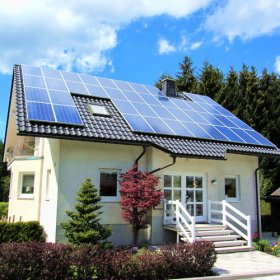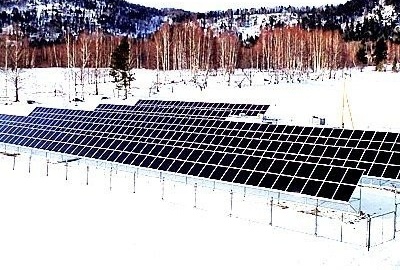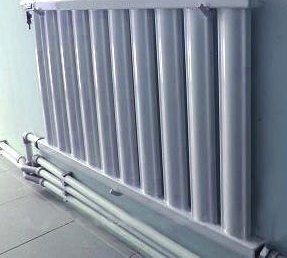Solar panels: classification + overview of domestic panels

More recently, autonomous energy systems for homes have seemed fantastic. Today they are confidently entering our lives. Leaning Europeans have long been using the so-called solar panels to provide their homes with electricity. In Russia, such systems are still gaining popularity. This is due to the relatively high cost of equipment. However, the technologies of its production are being improved, and the price of devices is gradually falling, making them more accessible to customers. What panels to choose for a private home? Let's get it right.
Content
The principle of solar cells
Devices that convert sunlight into electricity operate on a fairly simple principle. To understand it, just remember the school physics course. In particular, refresh knowledge of what a p-n junction is. It is he who is able to convert light energy into electrical energy. This phenomenon vividly illustrates the experience with a sawn-off transistor. Light falls on the pn junction, and the voltmeter connected to it begins to record insignificant values of the electric current. With an increase in the pn junction area, the amount of generated electricity will increase.

The principle of operation of solar panels is based on the conversion of light energy into electrical energy. The large area of the panels allows you to generate more energy.
All modern photovoltaic converters operate using this principle. The relatively large area of the plates with p-n junctions allows you to get enough electricity. Materials and design are undergoing continuous improvement, due to which the coefficient of photoelectric conversion increases, it is also the efficiency of the device. The magnitude of the voltage and output current of the solar battery directly depends on the degree of ambient light of the device.
Types of Photoelectric Converters
The number of varieties of modern solar panels is close to ten. Each variation has its own characteristics. All of them can be conditionally divided into two large groups - silicon and polymer film. Let us consider in more detail each of them.
Silicon solar panels
Devices generate direct current, which appears as a result of contact with a silicon or silicon-hydrogen plate of solar radiation. The features of the material are such that the rays of the sun falling on it shift electrons from the orbits of the atoms. The released electrons form an electric current.Such devices are characterized by maximum efficiency, but are quite difficult to manufacture, which makes them expensive. There are several varieties of silicon batteries.
View # 1 - Monocrystalline Converters
A distinctive feature of elements of this type is the direction of the photosensitive cells strictly in one direction. On the one hand, this is very good, because it allows you to get the highest of all similar efficiency systems. With single-crystal converters, it reaches 22%. However, for operation, the panel should always be turned towards the sun, otherwise the energy efficiency will decrease sharply.
Diffused light at sunset or dawn, on cloudy days gives a very small result, which makes single-crystal converters a good choice for southern areas where there are many sunny days. Externally, such systems can be easily distinguished by the beveled corners of the panels, which is due to the peculiarities of their manufacture, and the deep black color that the cells directed in one direction give.

Monocrystalline modules are characterized by the highest efficiency. They consist of silicon crystals oriented strictly in one direction.
View # 2 - Polycrystalline Batteries
Omnidirectional silicon crystals are located on the plates, which gives a lower efficiency as compared to single crystals. It is about 18%. The appearance of the panels is also different. They are plates of the correct square shape in dark blue. The heterogeneity of their structure and color is explained by the fact that they contain heterogeneous silicon crystals, and in addition, some impurities are present.

Polycrystalline solar cells are characterized by an inhomogeneous structure and the presence of silicon crystals oriented in different directions
For the manufacture of polycrystalline panels, not only primary silicon, but also prepared secondary raw materials can be used. This explains the presence of a certain number of defects in the equipment. The main advantage of such plates is their good energy efficiency in diffused light, which makes them indispensable for areas where cloudy weather is not uncommon.
View # 3 - amorphous silicon panels
Amorphous elements are very thin layers of silicon, which are obtained by spraying the material in a vacuum. The basis is foil made of high quality metal, plastic or glass. The efficiency of such devices is small and amounts to only 6%. This is explained by faster burnout of silicon layers than crystalline wafers under the influence of solar radiation. As practice shows, the effectiveness of amorphous panels after two months of operation is reduced by about 20%. After one and a half to two years, the battery may simply fail.

Modules made of amorphous silicon have a low efficiency, but they work very effectively in conditions of diffused light flux
However, their use is justified. The photosensitive cells are oriented randomly, which significantly increases the efficiency of the devices in cloudy weather and in scattered light. In addition, the degree of absorption of the incoming light flux in amorphous panels is almost twenty times higher than that of similar silicon competing devices. Non-waste technology for the production of such batteries can significantly reduce their cost. Externally, amorphous plates can be distinguished by a dark gray color.
View # 4 - Hybrid Photo Converters
Such panels combine microcrystals and amorphous silicon. The properties of hybrid light flux converters are very close to the properties of polycrystalline elements. The only difference is that their performance under ambient light conditions is much higher. Another distinguishing feature of such panels is the ability to convert not only ultraviolet radiation, but also infrared rays into electric current.
Polymer Film Solar Converters
A promising alternative to silicon batteries. They are a film consisting of a polymer active layer, aluminum electrodes, an organic flexible substrate and a special protective layer. Film solar cells are combined with each other, resulting in a roll solar battery. Such devices are very flexible, compact and lightweight. Their cost is slightly lower than silicon analogues, since expensive silicon is not used in the production. In addition, the devices are more environmentally friendly, since they have less impact on the environment.
The efficiency of such devices is low. It is about 6.5%. On an industrial scale, the first polymer batteries began to be produced in Denmark. The production process consists in a special multi-layer printing of a photocell on a special flexible film. It can subsequently be cut, twisted and made into solar panels of almost any size. The cost of film elements is an order of magnitude lower than that of silicon. However, finding such panels on sale is still very difficult. Production is at an early stage of development.

For the manufacture of polymer solar modules do not need expensive silicon, which significantly reduces the cost of production
What the market offers - manufacturers overview
A large assortment of poly- and single-crystal panels is presented on the Russian market. Most of them are made in China, which is not surprising, since this country is a leader in the production and sale of various solar power generation systems. German products from SCHOTT and Calixo, Japanese from SHARP and products from Russian companies are also represented on the market. The latter are most often involved in the assembly of solar cells from Chinese-made components.
Nevertheless, there are enterprises producing photoconverters. The Hevel plant, located in Novocheboksarsk, produces thin-film hybrid panels. The Saturn plant in Krasnodar specializes in solar panels operating on gallium arsenide. The latter are mainly intended for the space industry. Household modules are manufactured by two enterprises: “Plant of metal-ceramic devices” in Ryazan and “Telecom-STV” in Zelenograd.
The Ryazan plant produces two main types of devices:
- RZMP-130-T with a power range from 105 to 145 watts.
- RZMP-220-T with a power range from 200 to 240 watts.
Devices consist of several elements connected in series. The panel is covered with highly transparent tempered textured glass and placed in an aluminum profile. This design gives the battery strength and protects against adverse weather conditions. The cost of such devices is quite high. For example, the RZMP-130-T model, whose power is 120 watts, will cost the buyer more than 16,000 rubles.
Telecom-STV produces a lot more different models of solar panels. Among them are poly- and single-crystal modules, specialized and special flexible batteries, as well as high-efficiency single-crystal panels. The output voltage can be adapted for both high-voltage systems (34-38 V) and low-voltage (17-18.5 V).
Silicon modules are available in an aluminum frame, covered with a special textured glass. The manufacturer gives five years of warranty on its batteries and certifies its equipment, although by law this is not necessary. Zelenograd panels are lighter and less overall than Ryazan. Their cost is almost one and a half times lower, despite the fact that the quality of solar panels is consistently high.
Hevel Plant is the only one producing modules using micromorphic technology.These are plates made on the basis of amorphous silicon with a certain amount of interspersed microcrystals. The panels operate efficiently in ambient light and compete confidently with poly- and single-crystal batteries. The company has only just begun production, so it is not yet possible to find it in all stores. The cost of such panels is quite affordable. A device with a power of 125 W will have to pay about 10,000 rubles, which is slightly higher than that of the main competitor of Taiwan Green Energy Technology. Their products with similar properties cost about 7,000 rubles.
The range of solar panels is very wide. And only a person who is going to purchase a photoconverter can decide which option he should stop at. At the same time, it is worth considering the opinion of experts who recommend choosing polycrystalline modules for arranging autonomous power supply at home. It is clear that single-crystal are more effective, but we must not forget that this is a rather arbitrary indicator. The use of solar panels is becoming increasingly popular. Despite their high cost, these devices quickly pay off. And most importantly, they allow you to get the necessary electricity almost "out of nothing."





2 comments